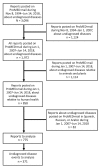Early Detection of Public Health Emergencies of International Concern through Undiagnosed Disease Reports in ProMED-Mail
- PMID: 31961311
- PMCID: PMC6986859
- DOI: 10.3201/eid2602.191043
Early Detection of Public Health Emergencies of International Concern through Undiagnosed Disease Reports in ProMED-Mail
Abstract
We conducted a retrospective analysis of all reports in ProMED-mail that were initially classified as undiagnosed diseases during 2007-2018. We identified 371 cases reported in ProMED-mail; 34% were later diagnosed. ProMED-mail could be used to supplement other undiagnosed disease surveillance systems worldwide.
Keywords: Disease Outbreak News; ProMED-mail; World Health Organization; early detection; emerging infectious diseases; global health; health security; international health regulations; outbreaks; public health emergencies of international concern; surveillance; undiagnosed diseases.
Figures


References
-
- World Health Organization. International Health Regulations (2005) third edition. 2016. [cited 2019 Jul 22]. https://apps.who.int/iris/bitstream/handle/10665/246107/9789241580496-en...
-
- World Health Organization Western Pacific Region. A guide to establishing event-based surveillance. 2008. [cited 2019 Jul 22]. http://www.wpro.who.int/emerging_diseases/documents/docs/eventbasedsurv.pdf
MeSH terms
LinkOut - more resources
Full Text Sources

